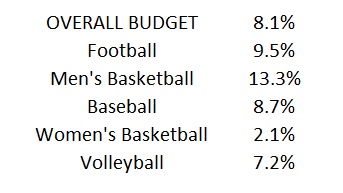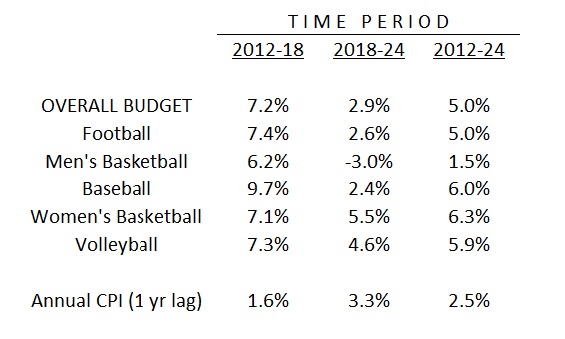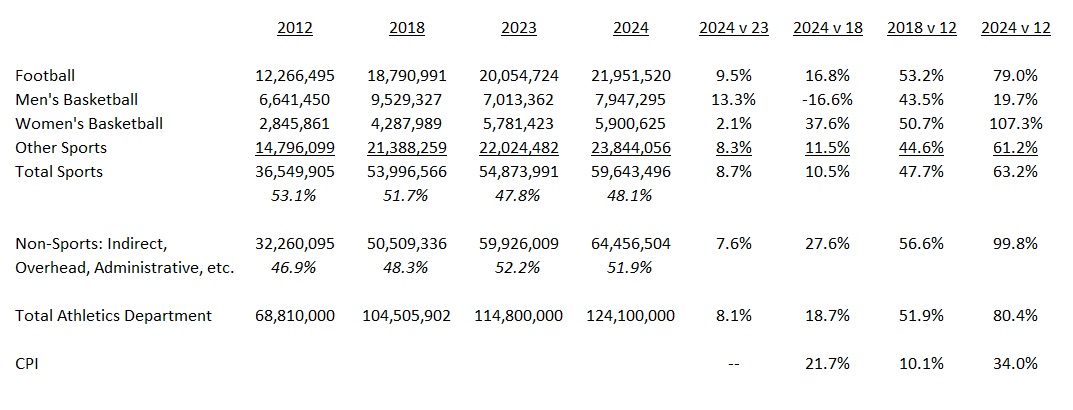This thread covers the 2024 budgets for the major individual sports at U of L. In my opinion, it shows where U of L is putting its emphasis as a department.
A nonprofit spends everything it brings in by definition. Its success is measured by growth and accomplishments. It doesn't control spending to be successful but rather to continue to operate.
I'll start the thread by posting the summary narrative that U of L published with the actual numbers. And I'll follow with my own condensed analysis of the sports budgets...
"The University of Louisville Athletic Association (ULAA) is pleased to present the following operating budget for the 2023‐2024 fiscal year. An internal working group of Senior staff provided the framework for this budget, meeting weekly during the budget process. The group was tasked with reviewing expenditure requests, propose and review cost saving measures, and discuss new ideas for revenue generation.
Unlike the prior two fiscal years, the target‐driven approach was replaced with a zero‐based budget approach providing management with the actual cost to operate the department post COVID. Total requests exceeded projected revenue by over $10 million. With fixed costs and debt obligations funded from operating rising significantly, the amount available for requests was minimal. As a result, most of the operating budgets are reverting back to 2022‐23 funding levels.
Revenues
Operating revenues are projected to increase $9.3 million to a record $124.1 million, $9.1 million of this increase is in the football program where ticket sales have been strong since the announcement of Jeff Brohm as the Head Coach. Ticket revenue is also bolstered by a favorable schedule featuring an additional home game (7 vs 6), a home schedule that includes Notre Dame and Kentucky, and a neutral site game in Indianapolis against Indiana. In addition to ticket sales, concessions, parking, and suite revenue are also projected to increase with a surge in attendance.
L&N Stadium continues to generate revenue for the Department. For 2023‐24, revenues are projected to increase $1.9 million over the 2022‐23 budget. Over $700,000 of this increase is related to the Beyonce concert scheduled for July. Parking revenue continues to grow and is projected to increase $142,000 over the current year. Revenues from club rentals are estimated to increase over $200,000 due to the demand for premium spaces.
Sport operating revenues are projected to increase slightly over the 2022‐23 operating budget. Men’s Basketball revenues are projected to decrease slightly by $315,800. This decrease is offset by increases in Women’s Basketball ($376,800 increase), Baseball ($54,000) and Volleyball ($112,000). Volleyball revenues are projected to increase due to high demand and moving 3 high profile games to the KFC Yum Center.
Staff continue to explore new revenue generation ideas and continue to build on those recently implemented. New premium spaces at both football and basketball are in process and will be rolled out prior to the seasons. The Season Ticket Member program, launched in 2022‐23, was very successful and
staff are making plans to grow this program. The split the pot or 50/50 in game contests is now fully operational and ready for growth in the upcoming fiscal year. Staff are also working on enhanced advertising for the new Angel’s Envy Club and The Alley to generate rental income. Investments made last year in concessions at L&N stadium should see a boost in return on investment with projected increased attendance at football.
Expenses
Overall, expenses for Fiscal Year 2023‐24 are increasing $9.3M on top of the $7.1M increase in fiscal year 2022‐23. While in 2022‐23 we invested over $2 million in NIL, mental health and the new season ticket member program, the proposed 2023‐24 budget addresses increased fixed costs, debt service and
compensation.
The largest increase in the 2023‐24 operating budget are salaries and benefits. This category is increasing $3.6 million with $1.2 million of the increase in benefits. While much of the increase in benefits is related to an increase in salaries, approximately $300,000 is attributed to insurance rates increasing $1,000 annually per person.
Approximately $2 million of the salary increase is related to the new football staff hired during the year. An estimated $400,000 was included for a 2% cost of living increase for staff and another $200,000 was included to support University salaries in Human Resources and University Counsel.
Debt service funded from operations is increasing $2.3 million for Fiscal Year 2023‐24. While the total annual amount owed toward principle (sic) and interest on debt has increased slightly due to the recent line of credit, the portion funded from the operating budget continues to increase. This is due to the expiration of several long‐term pledges and writing‐off delinquent past due amounts. For Fiscal Year 2023‐24, the debt service line increases from $6.8 million to $9.1M representing 77% of our total annual debt payment (up from 60% in 2022‐23). This percentage will continue to increase in future years.
Inflationary pressures continue to impact operations throughout the department but have been more detrimental to facilities. Unanticipated expenses for increased labor and materials costs are impacting Fiscal Year 2022‐23 and are being increased over $1.3 million for 2023‐24. These include:
The Athletic Department investment in student athletes continues to grow with a $1.3 million increase in financial aid. In addition to a 2% increase in tuition, an additional $100,000 was added to the summer School budget bringing the total to $1 million. A new item impacting the 2022‐23 budget was the Alston vs NCAA supreme court case. This ruling allowed schools to award an additional $5,980 per student for education related compensation. Established as the Red & Black Scholars in 2022‐23, $650,000 was allocated amongst the sports based on their equivalency. Students earned the award in the fall and were paid the following semester in the spring. The 2023‐24 budget provides an additional $1.1 million to fully fund the program at $1.7 million‐ allowing the two payments during the academic year."
A nonprofit spends everything it brings in by definition. Its success is measured by growth and accomplishments. It doesn't control spending to be successful but rather to continue to operate.
I'll start the thread by posting the summary narrative that U of L published with the actual numbers. And I'll follow with my own condensed analysis of the sports budgets...
"The University of Louisville Athletic Association (ULAA) is pleased to present the following operating budget for the 2023‐2024 fiscal year. An internal working group of Senior staff provided the framework for this budget, meeting weekly during the budget process. The group was tasked with reviewing expenditure requests, propose and review cost saving measures, and discuss new ideas for revenue generation.
Unlike the prior two fiscal years, the target‐driven approach was replaced with a zero‐based budget approach providing management with the actual cost to operate the department post COVID. Total requests exceeded projected revenue by over $10 million. With fixed costs and debt obligations funded from operating rising significantly, the amount available for requests was minimal. As a result, most of the operating budgets are reverting back to 2022‐23 funding levels.
Revenues
Operating revenues are projected to increase $9.3 million to a record $124.1 million, $9.1 million of this increase is in the football program where ticket sales have been strong since the announcement of Jeff Brohm as the Head Coach. Ticket revenue is also bolstered by a favorable schedule featuring an additional home game (7 vs 6), a home schedule that includes Notre Dame and Kentucky, and a neutral site game in Indianapolis against Indiana. In addition to ticket sales, concessions, parking, and suite revenue are also projected to increase with a surge in attendance.
L&N Stadium continues to generate revenue for the Department. For 2023‐24, revenues are projected to increase $1.9 million over the 2022‐23 budget. Over $700,000 of this increase is related to the Beyonce concert scheduled for July. Parking revenue continues to grow and is projected to increase $142,000 over the current year. Revenues from club rentals are estimated to increase over $200,000 due to the demand for premium spaces.
Sport operating revenues are projected to increase slightly over the 2022‐23 operating budget. Men’s Basketball revenues are projected to decrease slightly by $315,800. This decrease is offset by increases in Women’s Basketball ($376,800 increase), Baseball ($54,000) and Volleyball ($112,000). Volleyball revenues are projected to increase due to high demand and moving 3 high profile games to the KFC Yum Center.
Staff continue to explore new revenue generation ideas and continue to build on those recently implemented. New premium spaces at both football and basketball are in process and will be rolled out prior to the seasons. The Season Ticket Member program, launched in 2022‐23, was very successful and
staff are making plans to grow this program. The split the pot or 50/50 in game contests is now fully operational and ready for growth in the upcoming fiscal year. Staff are also working on enhanced advertising for the new Angel’s Envy Club and The Alley to generate rental income. Investments made last year in concessions at L&N stadium should see a boost in return on investment with projected increased attendance at football.
Expenses
Overall, expenses for Fiscal Year 2023‐24 are increasing $9.3M on top of the $7.1M increase in fiscal year 2022‐23. While in 2022‐23 we invested over $2 million in NIL, mental health and the new season ticket member program, the proposed 2023‐24 budget addresses increased fixed costs, debt service and
compensation.
The largest increase in the 2023‐24 operating budget are salaries and benefits. This category is increasing $3.6 million with $1.2 million of the increase in benefits. While much of the increase in benefits is related to an increase in salaries, approximately $300,000 is attributed to insurance rates increasing $1,000 annually per person.
Approximately $2 million of the salary increase is related to the new football staff hired during the year. An estimated $400,000 was included for a 2% cost of living increase for staff and another $200,000 was included to support University salaries in Human Resources and University Counsel.
Debt service funded from operations is increasing $2.3 million for Fiscal Year 2023‐24. While the total annual amount owed toward principle (sic) and interest on debt has increased slightly due to the recent line of credit, the portion funded from the operating budget continues to increase. This is due to the expiration of several long‐term pledges and writing‐off delinquent past due amounts. For Fiscal Year 2023‐24, the debt service line increases from $6.8 million to $9.1M representing 77% of our total annual debt payment (up from 60% in 2022‐23). This percentage will continue to increase in future years.
Inflationary pressures continue to impact operations throughout the department but have been more detrimental to facilities. Unanticipated expenses for increased labor and materials costs are impacting Fiscal Year 2022‐23 and are being increased over $1.3 million for 2023‐24. These include:
- $536,000 increase in security expenses at L&N Stadium and other athletic venues which includes $119,000 for magnetometer rental for football games.
- $250,000 increase in Physical Plant charges related to utilities and costs being allocated to Athletics by the University.
- $344,000 increase for year two of a three‐year phase‐in of the $1.1 million Microsoft/ERP University fee.
The Athletic Department investment in student athletes continues to grow with a $1.3 million increase in financial aid. In addition to a 2% increase in tuition, an additional $100,000 was added to the summer School budget bringing the total to $1 million. A new item impacting the 2022‐23 budget was the Alston vs NCAA supreme court case. This ruling allowed schools to award an additional $5,980 per student for education related compensation. Established as the Red & Black Scholars in 2022‐23, $650,000 was allocated amongst the sports based on their equivalency. Students earned the award in the fall and were paid the following semester in the spring. The 2023‐24 budget provides an additional $1.1 million to fully fund the program at $1.7 million‐ allowing the two payments during the academic year."
Last edited:




